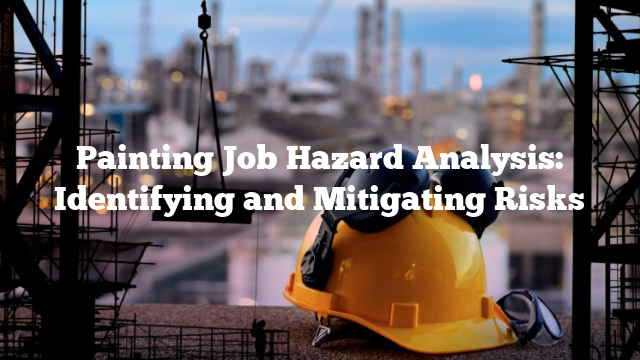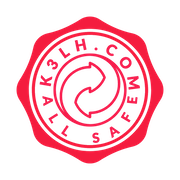![Painting Job Hazard Analysis: Identifying and Mitigating Risks Painting Job Hazard Analysis: Identifying and Mitigating Risks]()
Painting works can be a hazardous job, and job hazard analysis (JHA) is a necessary tool to ensure the safety of workers. JHA is a process that identifies potential hazards in a job, assesses the risk of those hazards, and determines ways to eliminate or reduce the risk. In this blog post, we will discuss in-depth the job hazard analysis for painting works, its importance, and how to conduct it effectively.
What is Job Hazard Analysis for Painting Works?
Painting works involve several hazards that can cause harm to workers, such as toxic chemicals, falls, electrocution, and fire. Job hazard analysis is a process that systematically identifies hazards in a job and determines ways to eliminate or reduce the risk.
Why is Job Hazard Analysis Important for Painting Works?
Job hazard analysis is essential for painting works to ensure the safety of workers and prevent accidents. It helps identify potential hazards before they occur and determine ways to eliminate or reduce the risk. By conducting JHA, employers can comply with OSHA regulations and provide a safer workplace for their workers.
Facts about Job Hazard Analysis for Painting Works
– According to OSHA, falls are the leading cause of death in the construction industry, and painting works are no exception.
– Painters are exposed to toxic chemicals such as lead, which can cause serious health problems such as anemia, kidney damage, and even death.
– Painting works involve the use of electrical equipment, which can cause electrocution if not used properly.
Tutorial of Job Hazard Analysis for Painting Works
1. Identify the job to be analyzed.
2. Break the job down into steps.
3. Identify potential hazards in each step.
4. Assess the risk of each hazard.
5. Determine ways to eliminate or reduce the risk.
6. Implement the plan.
7. Train workers on the identified hazards and how to prevent them.
Tips of Job Hazard Analysis for Painting Works
– Involve workers in the JHA process to get their input and feedback.
– Use a JHA worksheet to document the process and findings.
– Regularly review and update the JHA to ensure its effectiveness.
– Provide workers with personal protective equipment (PPE) to prevent exposure to hazards.
Question and Answer of Job Hazard Analysis for Painting Works
1. What is the purpose of a JHA?
A: The purpose of a JHA is to identify potential hazards in a job, assess the risk of those hazards, and determine ways to eliminate or reduce the risk.
2. Who should conduct a JHA?
A: Employers should conduct JHA, but it’s also essential to involve workers in the process to get their input and feedback.
3. What are the benefits of conducting a JHA?
A: Conducting a JHA can prevent accidents, comply with OSHA regulations, and provide a safer workplace for workers.
4. How often should a JHA be reviewed and updated?
A: A JHA should be reviewed and updated regularly to ensure its effectiveness.
Conclusion of Job Hazard Analysis for Painting Works
Job hazard analysis is a crucial tool for identifying potential hazards in painting works and determining ways to eliminate or reduce the risk. By conducting JHA, employers can comply with OSHA regulations and provide a safer workplace for their workers. It’s essential to involve workers in the JHA process, regularly review and update the JHA, and provide workers with personal protective equipment. By implementing these tips and conducting JHA effectively, employers can prevent accidents and ensure the safety of their workers.
Recommendations:
- Huge Collection of Lab Safety Poster Ideas, Make You Safe If you are assigning this to your students, we have more than 20 Lab Safety Poster Ideas. Please download the poster into your computer and save it. When creating a…
- Health And Safety Inspection Report Template Use for office health and safety audits. Add a badge to your website or intranet so your workers can quickly find answers to their health and safety questions. Safety Report…
- Safety Poster While we are talking about safety poster, most of us need to be a lot more familiar with the safety element of our lives.
- Construction Site Safety Topics Site organisation everything you need to know about organising a safe and healthy construction site. The department of labor does not endorse takes no responsibility for and exercises no control…
- Fire Safety Inspection Checklist Philippines Inspection after completion of construction. The following items can be used as a starting point for a fire safety inspection campaign. Fire Safety Checklist On Building Plans Final Stairs Wall…
- 10 Essential Industrial Safety Posters Every Workplace Needs Introduction: Safety is a top priority in any industrial environment, and the right safety posters can help remind workers of the potential hazards and the steps they can take to…
- Safety Inspection Safety inspections are required
- Understanding the Importance of Fire Safety Maintenance… Fire Safety Maintenance Report Sample BFP: Ensuring Your Safety Fires can be devastating, causing extensive damage to property and loss of life. As such, fire safety is a crucial aspect…
- Safety Hazards In School Special indexes listing the checklists by name career technical program and hazard will help select which checklists to use for each career technical course or program. Health and safety at…
- Fire Safety Inspection Certificate Sample Fire safety inspection certificate is a pre requisite prior to the issuance of occupancy permit. You can use this general fire safety checklist to facilitate routine fire inspections and evaluate…
- Workplace Safety Signs Images Workplace safety signs or industrial warning signs address a variety of problems by informing workers and visitors of potential dangers. Only show results related to. Workplace Safety Signs Browse 161598…
- Fire Safety Poster Template Get design ideas examples download templates edit print. The big list of free safety posters available for download. Fire Safety Posters Poster Template Be the first to review this product.…
- 5 Essential Tips for Preventing Workplace Slips, Trips, and… Introduction Slips, trips, and falls are the leading causes of workplace accidents and injuries. Whether you work in an office or a factory, the risk of slipping, tripping, and falling…
- Safety Topics For Fall Replace smoke alarm alkaline batteries at least once a year. Free safety topics toolbox talks safety meetings tailgate topics and safety resources including presentations photographs and documents. Fall Safety Tips…
- The Importance of Job Safety Analysis for Loading and… Job Safety Analysis for Loading and Unloading: Keeping Workers Safe As businesses continue to grow, loading and unloading activities have become more common. While these activities are necessary for the…
- Safety Vest With Tool Pockets Men women mesh utility multi pocket zip fishing work safety vest waistcoat new. Please fill in this form to get the best price quote and products catalog you will get…
- Motivational Poster On Fire Safety We have wide range of posters for industrial use covering topics like environment health safety fire safety ergonomics safety signs safety decals save energy conserve. Fire safety be cautious around…
- The Ultimate Fire Safety Inspection Checklist for Businesses… Fire Safety Inspection Checklist Philippines: Ensuring Safety and Compliance Fires can happen anytime, anywhere, and without warning. It can cause significant damage to property and even lead to loss of…
- Monthly Safety Inspection Form Observed form is provided to document that the hazard was reported. Here are some of the ways inspections can take place. B8 Monthly Crib Safety Inspection Form Includes checks for…
- 7 Essential Tips for Preventing Workplace Slips, Trips, and… Workplace Slips Trips and Falls Prevention Did you know that slips, trips, and falls are one of the leading causes of workplace accidents? According to the US Bureau of Labor…
- Fire Safety Poster Slogan Personal protection posters. List of 101 great fire safety campaign slogans. Foam Sheet Safety Slogan Poster Rs 280 8 Piece Protector Refer to earth day slogan to see how many…
- Fire Extinguisher Signage, Why so critical? Fire extinguisher signage is an important safety measure to ensure the safety of people and property in the case of a fire. It serves to inform building occupants of the…
- Workplace Safety Signs And Symbols, Why so important? Proper workplace safety signs and symbols always place in a construction site, mining site, oil and gas site or hospital and your workplace.
- Discover Job Hazard Analysis Examples to Improve Safety in… Job Hazard Analysis Examples. Every workplace has its own set of safety standards and procedures. But it can be difficult to know which safety protocols are most effective, and which…
- How to Prevent Workplace Slips, Trips, and Falls: A… Workplace Slips, Trips, and Falls Prevention: How to Keep Your Employees Safe Slips, trips, and falls are some of the most common accidents that happen in workplaces. According to the…
- Download 20+ Poster Making Fire Safety Drawing Ideas [Best… Find and download ideas about Poster Making Fire Safety Drawing Ideas on this blog. When learning about fire safety a poster making session can help kids remember the common sense…
- Health And Safety Inspection Form Safety inspections are essential to ensuring and effective safety program. More about download the free osh answers app. Workplace Health And Safety Inspection Forms Survey Templates And Alternatively they may…
- Fire Safety Company Logo Below is a list. 208 fire safety logo designs to browse. Entry 64 By J2creativegroup For Design A Logo For A Fire Safety Fire safety slogans can be used for…
- Safety Precautions Meaning Safety precautions meaning are measures taken to prevent or reduce the risk of accidents, injuries, illnesses, or damages in various settings and situations. Safety precautions are essential for protecting workers,…
- 7 Tips for Preventing Workplace Slips, Trips, and Falls Workplace Slips Trips and Falls Prevention As an employee or an employer, have you ever thought about the importance of preventing slips, trips, and falls in the workplace? Workplace slips,…
Advertisement
Scroll to Continue With Content




